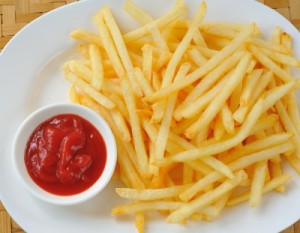Over the weekend, one of the other FPIES Mama’s on the boards mentioned taking her children to the circus. She had received special permission to bring food for her FPIES kiddo, but her kids really really really wanted cotton candy!
Fortunately, she remembered to check the ingredients first, which was very good. Turns out this particular cotton candy had SOY in it.
SOY. In COTTON CANDY.
Why the heck do you need soy in what is basically fluffy sugar?
She was properly horrified, and those of us who read her comment were in complete agreement: why do they have to put such junk in our foods?
I made a return comment about Burger King French Fries, basically saying that they are “safe” for Mr. Charm to eat (dairy, soy, fructose free) but that, after reading the ingredients with “FPIES Eyes”, I was horrified to feed them to my children.
The other Mama’s “got it” right away, but I realized…the world at large may not understand what I mean when I say “FPIES Eyes”. So, I thought I would explain it.
Prior to becoming an FPIES Mama, the most I ever heard anyone say about “reading food labels” was counting calories, carbs, protein or sodium. So, using my example of Burger King French Fries, let’s look at the label. From Burger King’s own website:
Medium French Fry
Not really great, right? But I’ve read worse labels in my life. It’s about what you’d expect of a fast food french fry, right?
So here comes Mr. Charm into my life, with his dairy/soy intolerance and egg allergy. Suddenly, I had to learn to read a little more closely.
No longer is the chart on the wall of the Burger King enough; now, before I even leave my house, I have to actually download the Burger King pdf for “nutrition”.
This is actually a fairly well-done nutrition guide; over on the right hand side, you’ll see a nifty little column titled “Allergens”. In that column, you’ll see lovely letters; for example, MWES. Translated, that means that particular food has Milk, Wheat, Egg, and Soy in it.
Pretty easy, right? Just scroll through the menu until you can find things that DON’T have your particular allergen, and you’re good to go, right?
Not so fast, Kemosabe. If you look at the listing for the Hamburger, you’ll see that is says WS Allergens are present. That’s Wheat and Soy. So…is the wheat and soy in the burger, or the bun? Or both? Now I have to email the company to ask.
In addition, there’s the cross-contamination issue. Burger King offers Onion Rings and Mozzarella Sticks, both of which are deep-fried. According to Burger King, they both contain Milk and Wheat, and the Mozzarella Sticks also have Egg and Soy. Are they deep-fried in the same fryer as the French Fries? Because if they are, well, the fries are not safe for Mr. Charm any more. This question is best left to the individual restaurant, generally, because each location can tell you if they have a dedicated fryer for their fries or not.
Are you mentally exhausted yet? Because I have had to do this for every fast food or regular restaurant experience we’ve had for the last two and a half years. ALL meals outside of the house were planned with this much foresight.
I had it pretty well under control; after two years of research, I had memorized all the restaurants and the individual items Mr. Charm could eat at those locations. Eating out wasn’t a challenge any more.
Then came Mr. Happy and FPIES. Now, looking at food through “FPIES Eyes”, I have found eating out to be a HUGE challenge again.
Let’s return to that pdf of Burger King nutrition, shall we?
Thanks to the way FPIES works in Mr. Happy’s little body, I have to know every single ingredient in the food he eats. (Hell, sometimes I have to know every single ingredient his food ate when it was alive!) So let’s scroll down further in that pdf until you see the “ingredients” list.
Straight from their pdf, here is what is in Burger King’s French Fries:
“FRENCH FRIES (Fried): Potatoes, Soybean Oil or Canola and Palm Oil, Modified Potato Starch, Rice Flour, Potato Dextrin, Salt, Leavening (Disodium
Dihydrogen Pyrophosphate, Sodium Bicarbonate), Dextrose, Xanthan Gum, Sodium Acid Pyrophosphate added to preserve natural color”
*
*
*
Say what???
ALL of that is in French Fries??
Wait, you may ask yourself, aren’t french fries just potatos fried with a little salt thrown on them?
Why yes, as a matter of fact, you are correct! Unless you’re a fast food joint. Then French Fries are “Potatoes, Soybean Oil or Canola and Palm Oil, Modified Potato Starch, Rice Flour, Potato Dextrin, Salt, Leavening (Disodium Dihydrogen Pyrophosphate, Sodium Bicarbonate), Dextrose, Xanthan Gum, Sodium Acid Pyrophosphate added to preserve natural color.”
OK, so let’s look at this list with “FPIES Eyes”. If you haven’t already just turned away in horror, stay with me while I break this down. There’s a great book called “A Consumer’s Dictionary of Food Additives” by Ruth Winter. I broke out my copy and used it to decipher the ingredients in Burger King French Fries:
- Potatos – straight forward. If potatos are a safe food for your kiddo, you’re good to go.
- Soybean Oil OR Canola and Palm Oil – Wait a sec – didn’t their allergen list say NONE for allergens? How is that possible if they ‘may’ use soybean oil in their fries? Soy is a top 8 allergen! Hmm…though, other than that little misleading tidbit, this is straight-forward. If your kiddo is safe with soybean, canola or palm oils, you’re good to go.
- Modified Potato Starch – to quote from the book: “Ordinary starch that has been altered chemically to modify such properties as thickening or jelling. Babies have difficulty digesting starch in its original form. Modified starch is used in baby food on the theory that it is easier to digest. Questions about safety have arisen because babies do not have the resistance of adults to chemicals. Among chemicals used to modify starch are propylene oxide, succinic anhydride, 1-ocetnyl succinic anhydride, aluminum sulfate, and sodium hydroxide. On the FDA top priority list for reevaluation since 1980. Nothing new reported by the FDA since.” OK, OK, wait…do we want to flip through the book and look up all the chemicals used to jack with our potato starch, or do we want to call this a big fat “NO”, and move on? Well, depends on how restrictive your child’s diet is. You may have the luxury of being able to say “Next!” but you may be so desperate for a food your baby can eat that you’re willing to feed them something that has been modified by something that likely causes an increased risk of cancer (propylene oxide). Ahem. Moving on…
- Rice Flour – DING DING DING! We have a major FPIES no-no here! Rice is one of the top FPIES trigger foods; aside from that, why on EARTH do you need to add RICE to a french fry??
- Potato Dextrin – In the book, there is no listing under “potato dextrin”, however, there is a listing for “Dextrin”: “British Gum. Starch Gum. White or yellow powder produced from starch and used as a foam stabilizer for beer, a diluting additive for dry extracts and pills, in polishing cereals, for preparing emulsions, and in matches, fireworks, and explosives. May cause an allergic reaction.” Um…sounds delicious, doesn’t it!
- Salt – This is sort of straight-forward. Salt is salt, right? WRONG. If you have a “corn-sensitive” FPIES kiddo, this might be a problem, because ordinary iodized table salt contains dextrose, which is often corn-derived. So, maybe.
- Leavening (Disodium Dihydrogen Pyrophosphate, Sodium Bicarbonate) – Ms. Winter has no listing for Disodium Dihydrogen Pyrophosphate, but she does have a listing for Disodium Pyrophosphate: “An emulsifier and texturizer used to decrease the loss of fluid from a compound.” Sodium Bicarbonate, of course, is Baking Soda. So, the first is kind of icky sounding, though generally regarded as safe, and the second is innocuous. However, I repeat the question: why is this necessary in a french fry??
- Dextrose – CORN SYRUP. No problems with corn? You’re good to go. Problems with corn? NO.
- Xanthan Gum – A FAM (Food Allergy Mama) or FPIES Mama is well versed in xanthan gum: it’s one of the two ways you can make baked goods that seem like normal, gluten-filled baked goods! However, xanthan gum, while generally regarded as safe, is derived from corn. So, again, corn okay? No problem. Corn bad? NO.
- Sodium Acid Pyrophosphate – “A white mass or free-flowing powder used as a buffer. It is a slow-acting acid constituent of a leavening mixture for self-rising and prepared cakes, doughnuts, waffles, muffins, cupcakes, and other types of flours and mixes. Also used in canned tuna fish. The U.S. Department of Agriculture has proposed that SAP be added to hot dogs and other sausages to accelerate the development of a rose-red color, thus cutting production time by some 25 to 40 percent. It is related to phosphoric acid, which is sometimes used as a gastric acidifier. Generally Regarded As Safe.” Um, yeah. Generally regarded as safe. And it sounds DELICIOUS, too!!!
THAT, my friends, is what you learn about Burger King French Fries when you’re looking at food through “FPIES Eyes”.
For comparison, follow this link for MY recipe and ingredient list for French Fries!
(And people wonder why I say that even after (God willing) Mr. Happy outgrows FPIES, I’m STILL going to make nearly all of our food from scratch at home. Puh-lease!)
Anyway, THAT is what “FPIES Eyes” are. They are the eyes that look at the smallest, most inconsequential ingredient in a food with a critical, evaluating appraisal. They are the eyes that investigate the packaging of the food that our kiddos eat, wondering if it could have leeched something into the food.
And don’t EVEN get me started on the art supplies…non-toxic is just code for “poison my FPIES baby”! (Non-toxic means corn and soy derived, generally, which are high up on the list of FPIES triggers.)
Fellow FPIES/FA Mamas, did I explain this well for our non-FPIES/FA friends? Let me know if I left anything out!












This is brilliant — totally explains why eating out is a minefield for FPIES families. We are very fortunate to have safe fries from a chain here in California — In n Out. Just potatoes, cottonseed oil and salt on a dedicated fryer. We will be customers for life!
LOVE In n Out Burger! The food wasn’t as phenomenally good as I had heard, but I LOVED that the ingredients were so simple and pure. (The food was good, but the way In n Out Fans talk, you’d think it was manna from Heaven! LOL) Wish we had them here…lucky you!
Good grief that is insane! They really do put a lot of useless crap in our food!
Crazy!! Wish I didn’t have to have FPIES eyes 🙁
Me, too, honey!
Fabulous post!!! It is exhausting to just think about it, let alone write it all out!! Thanks for sharing…and I will share on my blog too!
Thanks for sharing!
‘non-toxic is just code for “poison my FPIES baby”!’ ha! I am so putting that book on my amazon wish list.
I totally get FPIES Eyes! My son’s FPIES trigger is soy as well (IgE to dairy) but he can actually handle cooked oils (like BK french fries). But I am totally not taking any chances with Crayola art supplies.
That’s great that your son can handle cooked oils! I’m still searching for safe art supplies, though. 🙂 This is why FPIES Mama’s are so paranoid, though. “This” form is safe, “this” form of the same thing is not! LOL Crazy-making!
Pingback: What’s In YOUR Honey? - Cradle Rocking Mama
Pingback: Step A-waaay From the Playground Equipment! - Cradle Rocking Mama
Pingback: *WE* Have FPIES Eyes! - Cradle Rocking Mama
Pingback: The Best of Cradle Rocking Mama’s First Year - Cradle Rocking Mama
Pingback: The Mommy Drive-Thru | Perfection Pending
This is our Fpies life. It’s obscene what goes in to the simplest of good! This post resonates so much with us as we too face this battle daily. Fpies eyes is the best term I’ve heard x
It is obscene, isn’t it? I’m sorry you’re having to deal with this, but glad the post resonated with you! I STILL view the whole world with FPIES eyes, even today, when my son has technically outgrown all but one of his triggers.